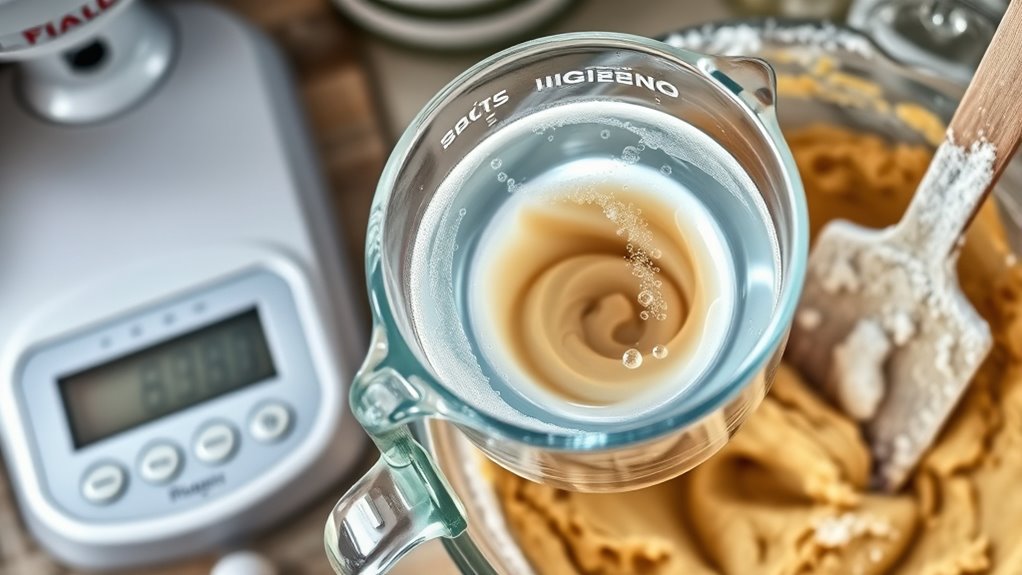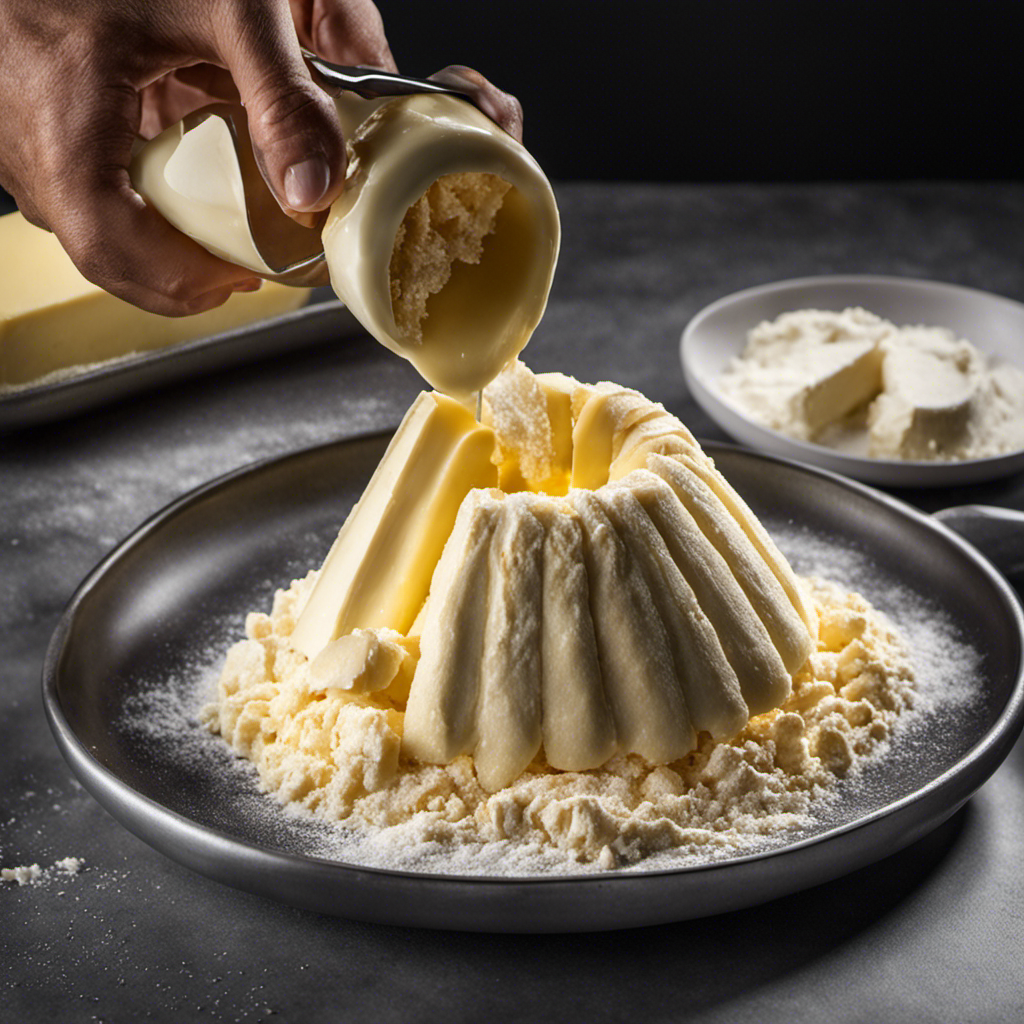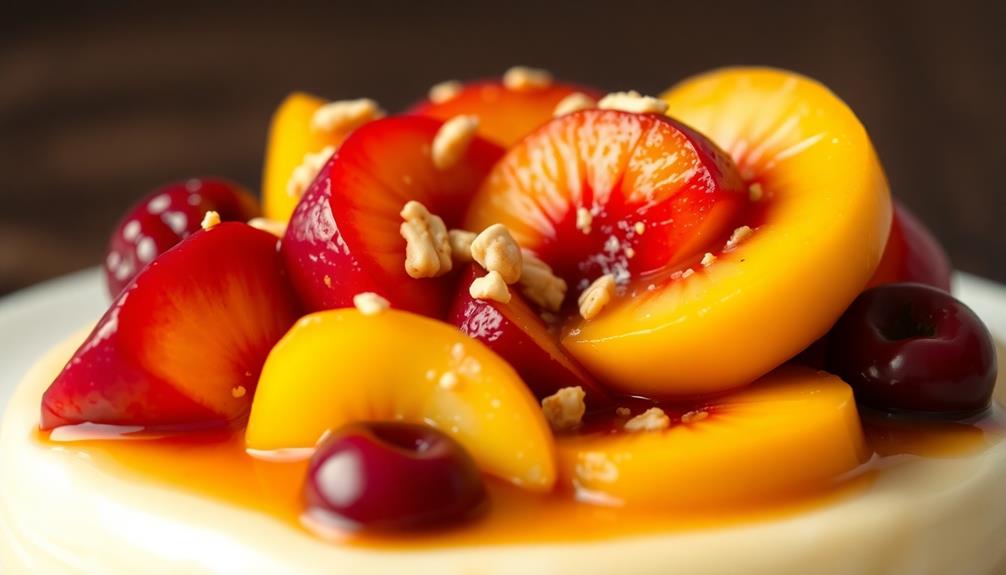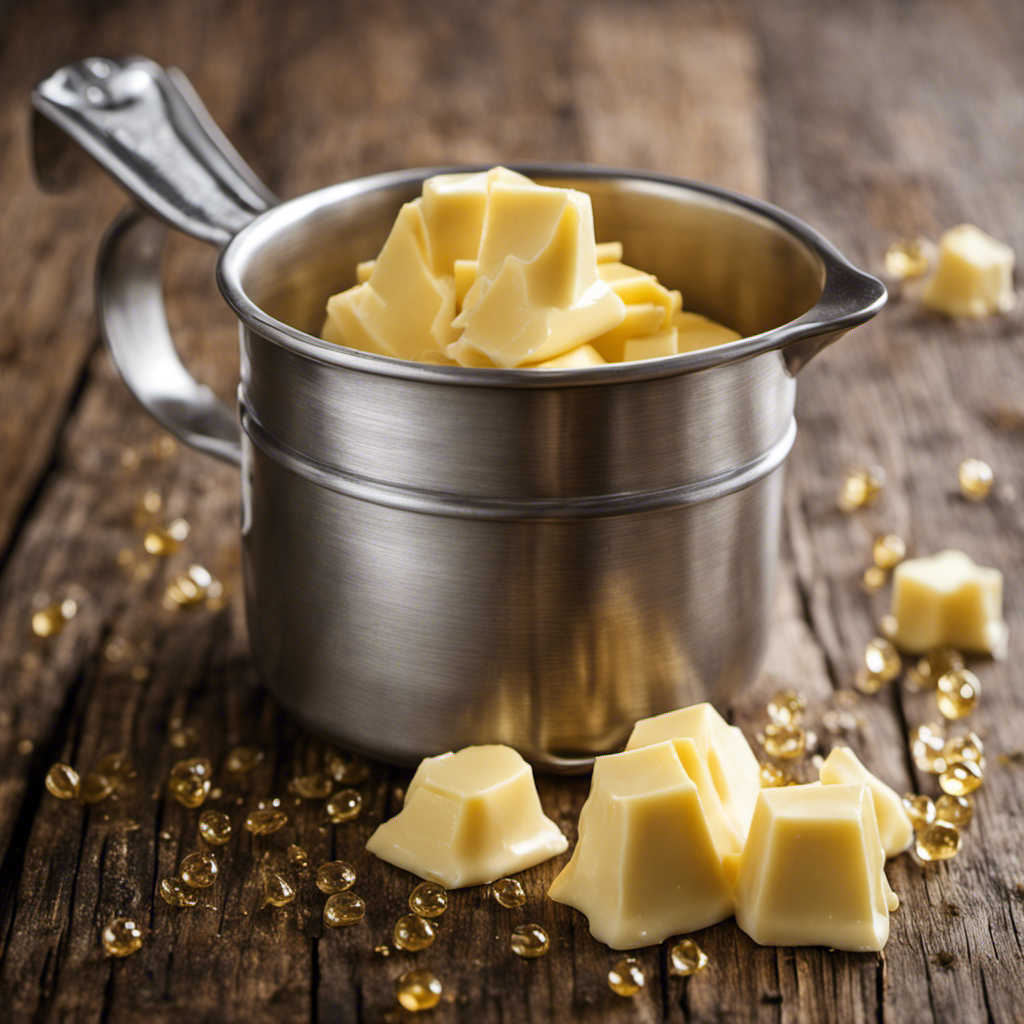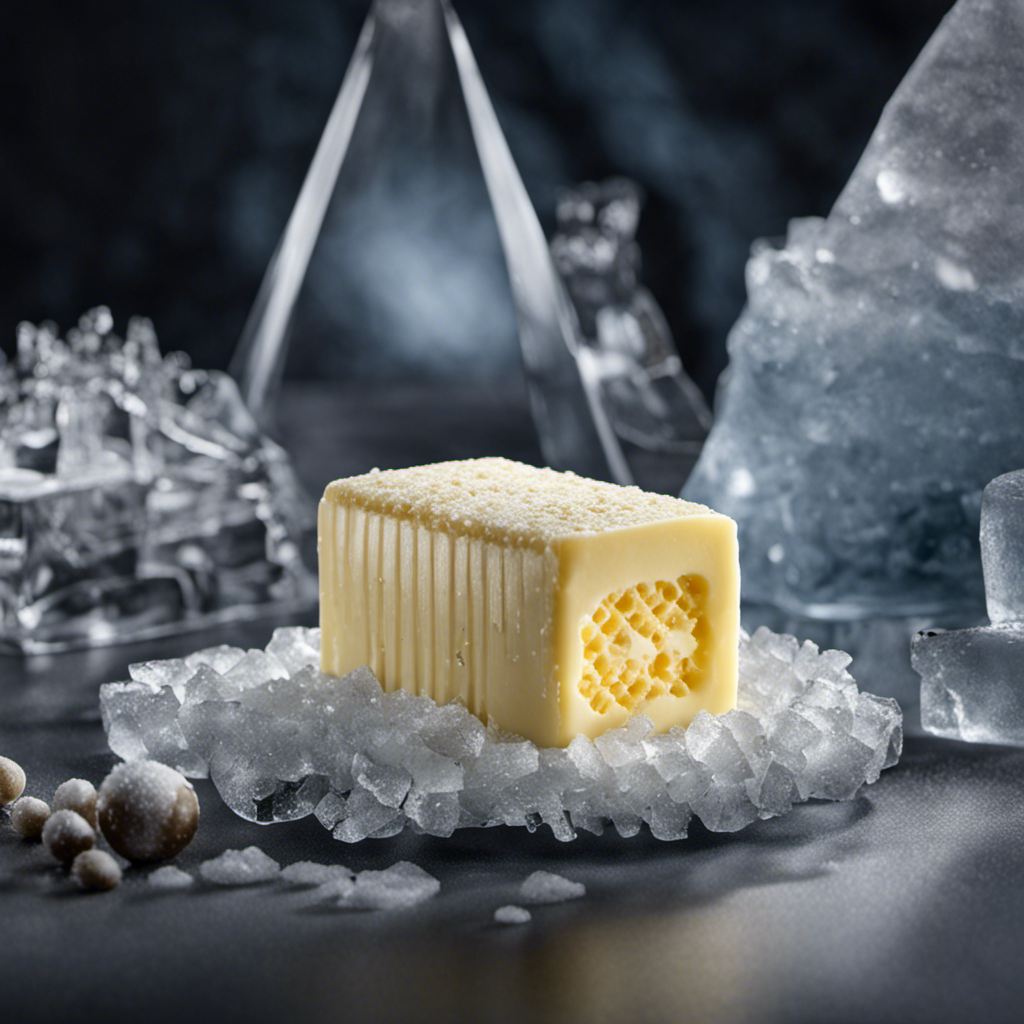To prevent butter-heavy batters, you need to calculate the right water amount based on your ingredients. Start by determining the water content in your dry and moist ingredients, then adjust the added water accordingly. Keep your batter’s consistency smooth and pourable without separating or becoming too stiff. Fine-tuning this ratio helps avoid issues like separation or dense texture. To discover more on perfecting your batter balance, explore the detailed techniques below.
Key Takeaways
- Review ingredient moisture content and substitute moist ingredients to adjust total water while maintaining batter consistency.
- Increase water proportionally when replacing dry ingredients with higher-moisture components like yogurt or applesauce.
- Use precise measurements with calibrated tools to ensure accurate water-to-flour ratios, preventing butter-heavy batter.
- Adjust water gradually during mixing, observing batter texture to achieve desired pourability without excess looseness.
- Balance butter reduction with increased water or liquids to maintain batter stability and prevent excessive spread during baking.
Understanding the Role of Water in Baking Batters
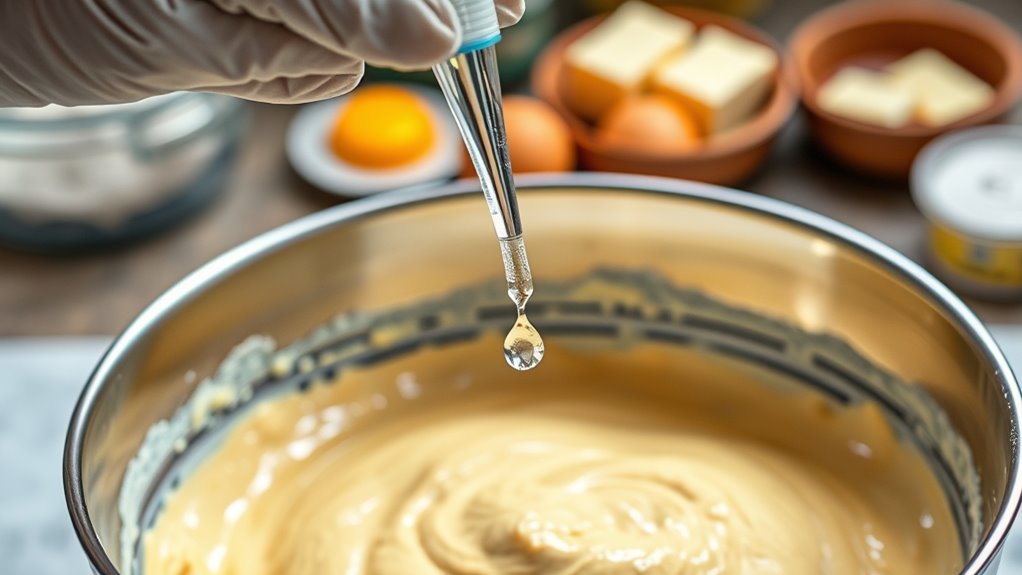
Water plays a crucial role in baking batters because it activates gluten proteins and hydrates starches, which are essential for creating the right dough consistency. When you add water, it’s absorbed by flour particles, leading to water absorption that promotes gluten development. As gluten proteins hydrate, they form a flexible network that provides structure and elasticity to your batter. Proper water absorption ensures your dough isn’t too sticky or too dry, making it easier to work with. Without enough water, gluten development stalls, resulting in a weak structure. Conversely, too much water can make the batter overly loose. Understanding how water interacts with flour helps you control the batter’s texture, guaranteeing optimal gluten formation and consistent results in your baked goods. Additionally, controlling water content can influence the dough consistency, which is vital for achieving the desired texture in baked products.
How Butter Content Affects Batter Consistency
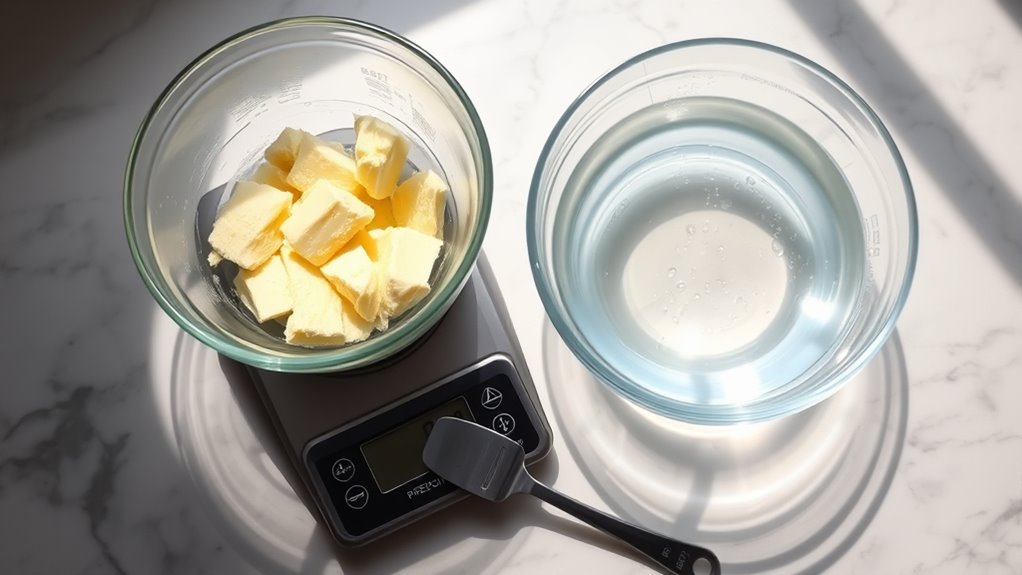
Your butter content directly influences the batter‘s texture, making it richer or more tender. Too much butter can cause the batter to spread excessively, affecting the final shape. Finding the right balance with water and butter guarantees consistent results every time. Additionally, incorporating calibration techniques can help ensure the proper proportion of ingredients for optimal batter consistency.
Butter’s Role in Texture
Butter plays a critical role in shaping batter texture by influencing its consistency and mouthfeel. When butter melts into the batter, it creates a smoother, richer base that enhances tenderness. However, the amount of butter affects water evaporation during baking; too much butter can lead to rapid water loss, resulting in a drier, denser texture. Conversely, insufficient butter may cause the batter to be overly loose and crumbly. The melting process also releases fats that coat flour particles, strengthening the batter’s structure. By balancing butter content, you control how much water evaporates and how the batter develops during baking. Additionally, the incorporation of butter can influence the batter’s AI-powered virtual reality in e-learning, affecting how the texture is perceived visually and tactilely. Proper butter levels ensure a moist, tender crumb without compromising the batter’s stability, ultimately shaping the desired texture of your baked goods.
Impact on Batter Spread
The amount of butter in a batter directly influences its spread during mixing and baking. Too much butter makes the batter spread quickly, resulting in a thinner, flatter final product. This can be desirable if you want a delicate, tender crumb but problematic if you need a thicker texture. Using dairy alternatives, such as plant-based butters or oils, can modify spread behavior by altering fat content and consistency. These alternatives often have different melting points, which impact how the batter flows. Additionally, butter’s flavor enhancements contribute to a richer taste but can also affect spread if used excessively. Balancing butter and water content helps control batter spread, ensuring consistent results whether you prefer a light, airy texture or a denser, more substantial crumb. Incorporating the right butter content can also prevent the batter from becoming too greasy or too stiff, leading to a more controlled and even bake.
Balancing Water and Butter
Since butter’s fat content considerably influences batter consistency, balancing it with water is essential for achieving the desired texture. Your choice of flour affects how much water you need; denser flours absorb more moisture, requiring adjustments to butter and water ratios. Too much butter can make the batter heavy and greasy, while insufficient water leads to dryness and poor rising. To counteract this, you may need to tweak the water content based on your flour selection. Additionally, oven temperature impacts how the batter sets and rises during baking. Properly balancing water and butter ensures the batter maintains the right viscosity for even spreading and ideal oven performance. Understanding flour absorption is key to fine-tuning your batter for consistent results every time.
Tools Needed for Accurate Water Measurement
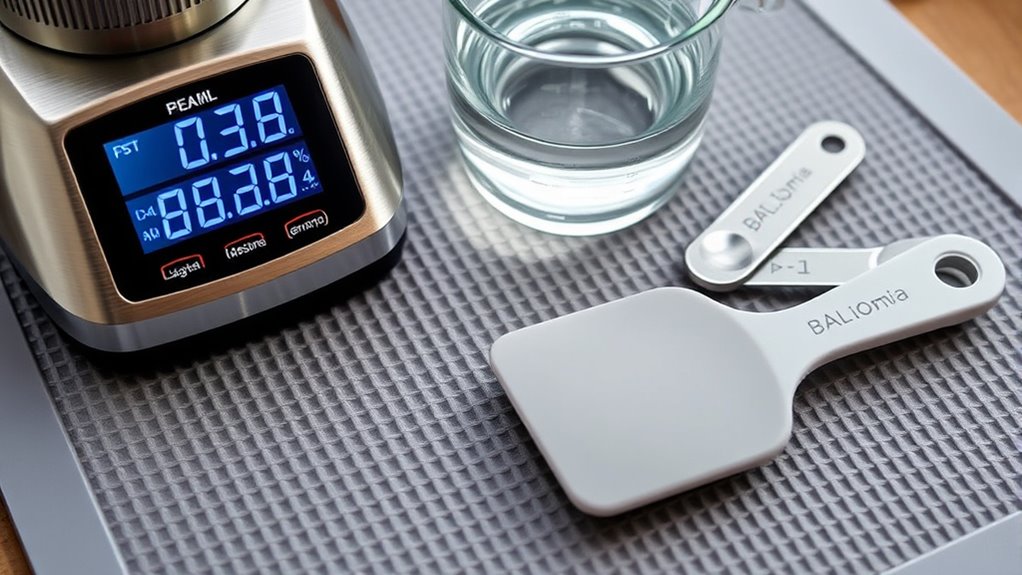
To measure water accurately, you need the right tools for precision. Selecting equipment that suits your needs and calibrating it properly guarantees reliable results. Using accurate tools helps you maintain the perfect batter consistency every time.
Tools for Precision Measurement
Accurate water measurement relies on using the right tools, ensuring your batter maintains the correct consistency. Proper measuring tools and calibration techniques are essential to achieve this. First, invest in a high-quality digital scale for precise weight measurements. Second, use graduated measuring cups or syringes for liquid volumes, providing clear accuracy. Third, regularly calibrate your tools—testing them with water to confirm their measurements are correct. Fourth, keep your measuring tools clean and dry to prevent errors. These steps help you avoid mistakes that could lead to butter-heavy batters. Additionally, understanding how different tuning options can affect engine performance allows you to fine-tune your vehicle for optimal results. When you rely on precise measurements, your batter’s texture stays perfect, and your baked goods turn out flawless every time. Small details matter—accuracy in water measurement makes all the difference.
Selecting the Right Equipment
Choosing the right equipment is essential for precise water measurement in your batter. To enhance battery performance during mixing, use a digital scale with high accuracy, especially when adjusting flour substitution ratios. A reliable graduated measuring cup ensures you add the exact water amount needed without estimation errors. Avoid using standard kitchen spoons, which lack precision. Consider a moisture meter if you’re experimenting with flour substitution, as it helps determine the water absorption rate of different flours. Using precise tools ensures consistent results, preventing butter-heavy issues caused by incorrect water content. Investing in quality equipment streamlines your process, reduces waste, and improves batter consistency. Accurate measurement tools are crucial for maintaining ideal batter texture and achieving the best baking outcomes. Additionally, understanding the relationship between ingredients can help you fine-tune your measurements for optimal results.
Calibrating for Accuracy
Making sure your water measurements are precise starts with calibrating your tools correctly. Accurate measurement is essential for dough elasticity and flavor enhancement, preventing butter-heavy batters. To achieve this, check your tools regularly.
- Use a digital scale to measure water for consistency and precision.
- Calibrate your measuring cups and spoons with water to ensure they hold accurate volumes.
- Test your thermometer regularly to confirm it reads correctly, especially if measuring temperature-sensitive ingredients.
- Keep a measurement log to track any discrepancies and adjust your process accordingly.
Identifying the Ideal Water-to-Other Ingredients Ratio
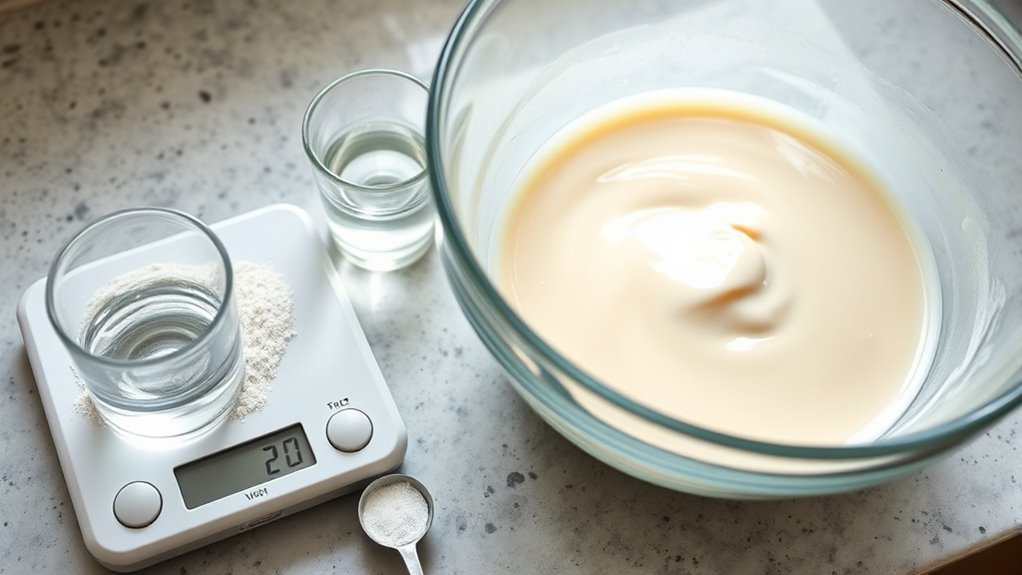
Finding the right water-to-other ingredients ratio is vital for preventing butter-heavy batters. Achieving ideal water retention ensures your batter stays moist without becoming too dense or greasy. To do this, consider how much water is needed to hydrate the dry ingredients properly—this is key for ingredient hydration. Too little water can lead to poor water retention, resulting in a stiff, unworkable batter that promotes excess butter separation. Conversely, too much water makes the batter runny, causing butter to separate and creating a heavy texture. Start by evaluating your recipe’s ingredient properties and adjusting water amounts accordingly. By fine-tuning this ratio, you’ll improve batter consistency, enhance ingredient hydration, and effectively prevent butter-heavy issues. Balance is vital for perfect baking results.
Calculating Water Content Based on Recipe Ingredients
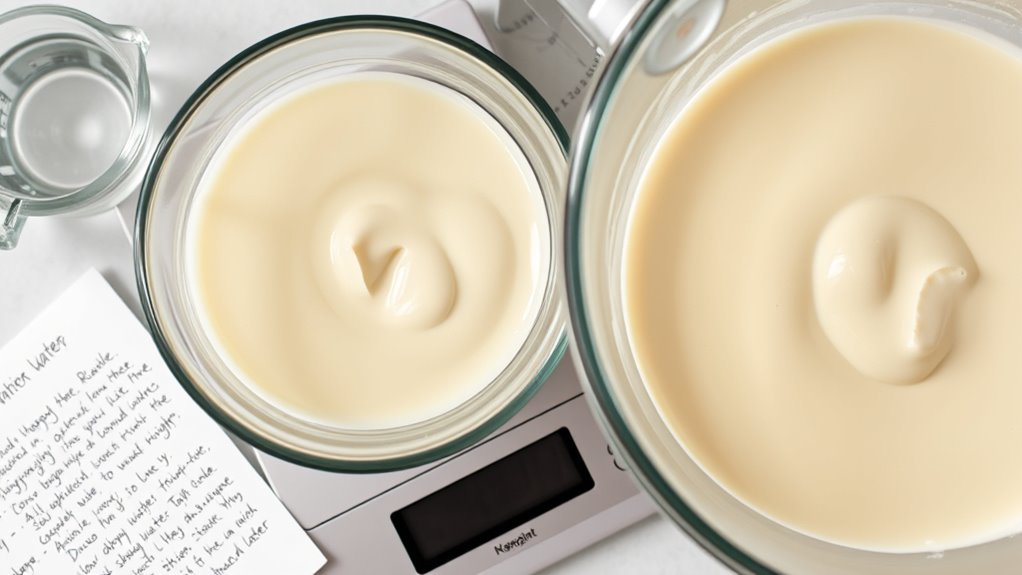
Once you’ve established the ideal water-to-ingredients ratio, the next step is to calculate the actual water content based on your recipe’s specific ingredients. To do this effectively:
- Review your ingredient list and determine the moisture content of each, considering ingredient substitution options to improve texture or flavor enhancement.
- Adjust the water amount if you replace dry ingredients with moist ones, ensuring the batter isn’t butter-heavy.
- Balance the water added to compensate for ingredients with low moisture or to intensify flavors without risking excess liquid.
- Keep track of how each substitution impacts overall hydration, so your batter remains consistent and perfect every time.
- Incorporating precise data analysis ensures the batter’s consistency and helps prevent overly heavy batters while allowing creative adjustments to perfect your recipe.
Adjusting Water Levels for Different Types of Batters
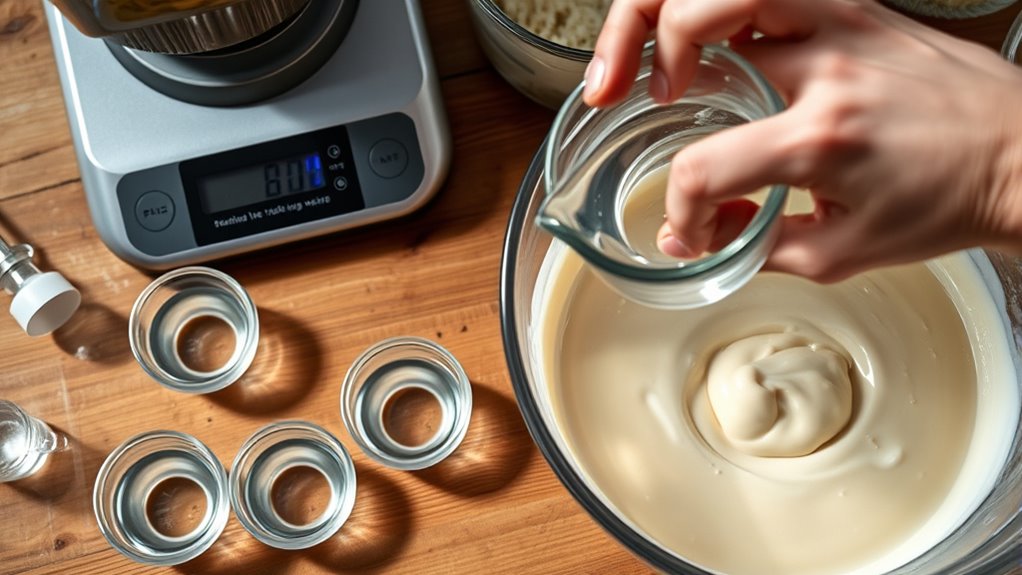
Different batter types require different water adjustments to achieve the right consistency. You need to take into account how hydration affects texture and how much water each recipe needs. Making these tweaks ensures your batter isn’t too heavy or too runny.
Batter Type Variations
Adjusting water levels is essential because different batter types require specific hydration to achieve ideal results. For example, a delicate crepe batter needs less water, while a hearty bread batter needs more. When considering butter flavor, remember that ingredient substitutions, like applesauce or yogurt, can alter moisture content—so you may need to tweak water levels accordingly.
Here are four ways to adapt:
- Use less water for rich, buttery batters to prevent heaviness.
- Increase water when replacing butter with moist ingredients.
- Adjust hydration based on the desired batter consistency—thick or pourable.
- Recognize that certain batters, like tempura, require more water to achieve crispness.
Tailoring water content based on batter type ensures perfect texture and flavor, regardless of ingredient substitutions or butter flavor intensity.
Hydration Adjustments Needed
To achieve the perfect batter consistency, you need to modify water levels based on the type of batter you’re making. Different ingredients absorb water at varying rates, so understanding water absorption helps you adjust accordingly. For example, whole wheat flour absorbs more water than all-purpose flour, requiring increased hydration. Ingredient interaction also influences water needs; fats like butter can inhibit gluten development, meaning you may need to add slightly more water to compensate. Pay attention to how your ingredients behave during mixing, and adjust water levels gradually. Too little water results in a dry, heavy batter, while too much makes it thin and difficult to handle. Fine-tuning hydration ensures ideal ingredient interaction, leading to a batter that’s just right.
Consistency and Texture
Once you’ve modified water levels based on ingredient absorption, paying attention to the batter’s consistency and texture becomes key. A batter that’s too thick can hinder butter flavor integration, while one that’s too thin risks compromising shelf stability. Adjust water carefully to achieve a smooth, pourable texture that supports even mixing. Consider these factors: 1. Feel the batter’s flow—should glide easily without dripping excessively. 2. Check for uniformity—no lumps or streaks, ensuring consistent butter flavor distribution. 3. Observe how it coats a spoon—coats evenly without running off. 4. Assess stability—batter should hold shape without spreading too thin. Additionally, ensuring the batter maintains a balanced water content helps prevent butter heaviness and supports optimal shelf life. Balancing water ensures your batter maintains the desired texture and shelf life, preventing butter heaviness while preserving the perfect butter flavor.
Common Mistakes That Lead to Butter-Heavy Mixtures
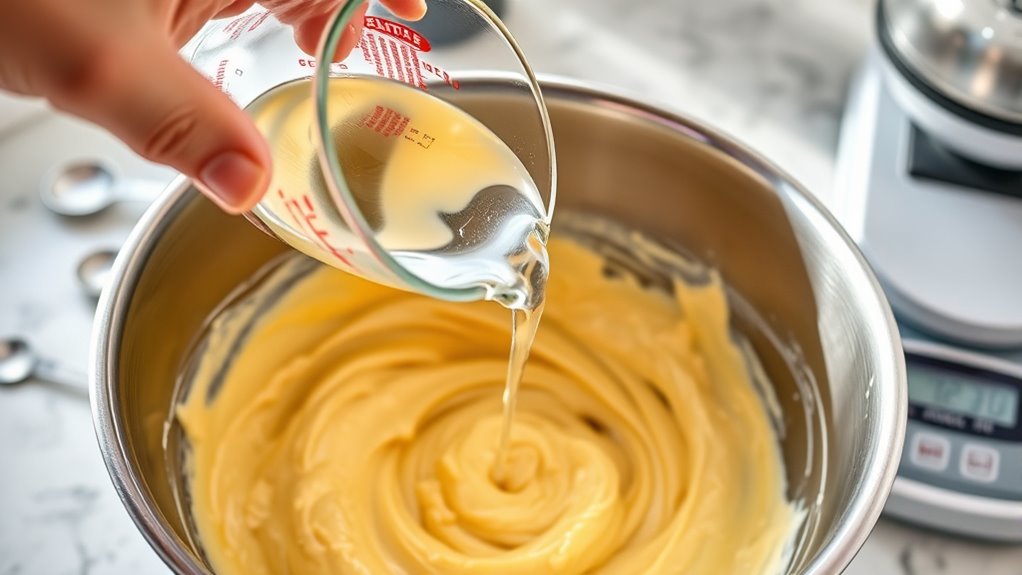
One common mistake that leads to butter-heavy mixtures is using too much butter relative to other ingredients. When you rely heavily on butter substitution for flavor enhancement, it can easily overpower the batter’s balance. This often causes the mixture to become greasy and dense, affecting texture and rise. To avoid this, measure your butter carefully and consider reducing its amount when aiming for a lighter batter. Relying too much on butter for flavor can also mask other ingredients’ qualities, resulting in a heavy, unbalanced consistency. Instead, focus on integrating water or other liquids to achieve a proper moisture level. Maintaining proper proportions helps prevent the batter from becoming butter-heavy and ensures a better, more even texture. Additionally, understanding the environmental considerations of your ingredients and tools can help maintain sustainable baking practices.
Techniques for Correctly Mixing Batter to Maintain Balance
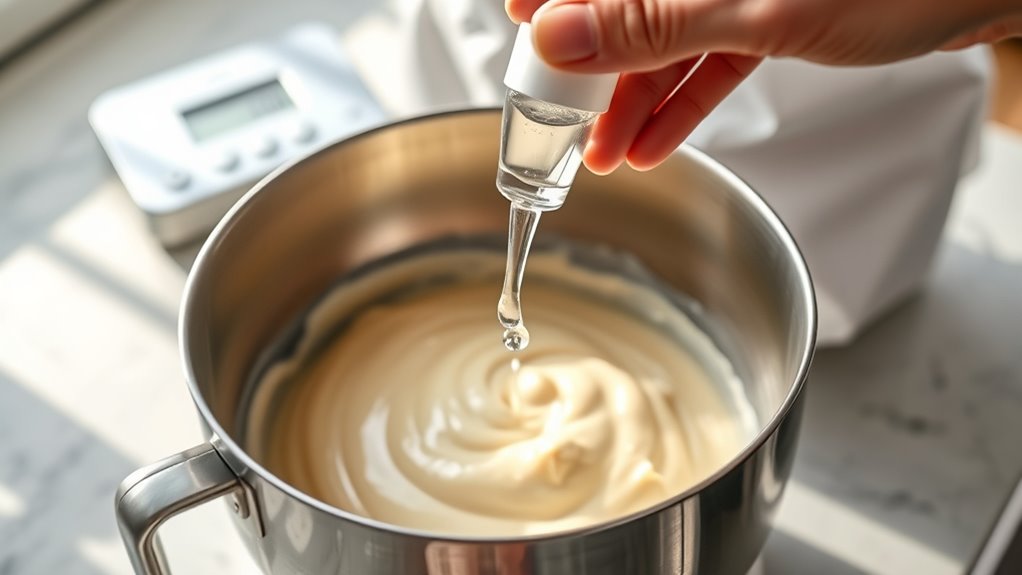
Proper mixing techniques are key to maintaining a balanced batter, especially after avoiding overuse of butter. When you mix carefully, you facilitate flavor enhancement and guarantee your batter’s consistency supports stunning presentation techniques. To achieve this:
- Gently fold ingredients to preserve air, creating a light, tender texture.
- Avoid overmixing, which can make the batter dense and dull flavor-wise.
- Incorporate liquids gradually to control water content and prevent butter heaviness.
- Use a spatula to scrape the sides, ensuring even mixing and a smooth batter ready for eye-catching presentation.
Using Empirical Methods to Fine-Tune Your Batter
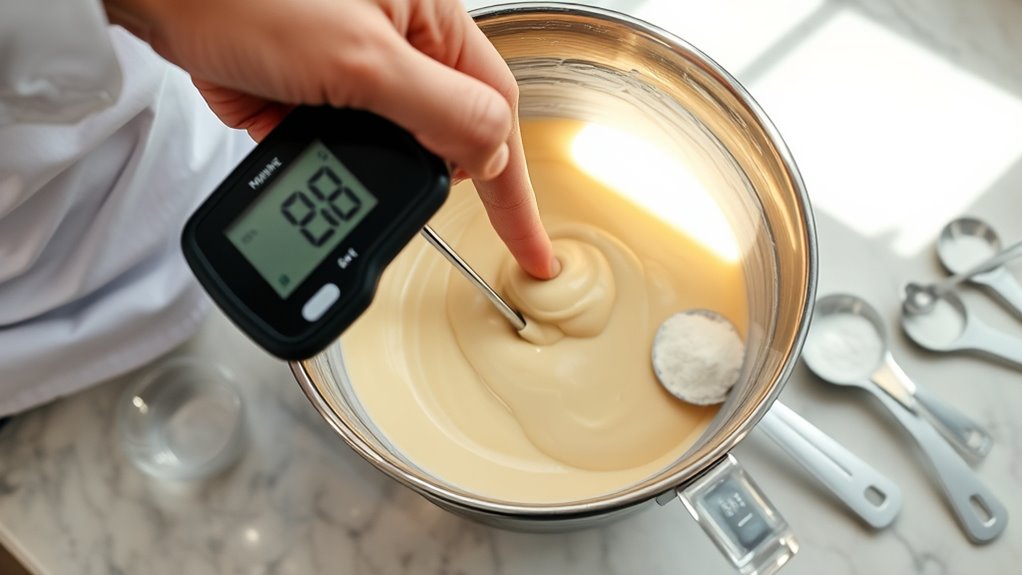
To achieve the ideal batter consistency, you need to rely on empirical methods that allow you to adjust ingredients based on observed results. Water absorption varies with different ingredients, so monitoring how your batter reacts helps you make precise adjustments. Pay close attention to ingredient interactions; for example, adding more liquid may loosen the batter, but too much can cause separation or a butter-heavy texture. Use small test batches to observe how changes affect the overall consistency. Record your adjustments and outcomes to refine your process over time. This hands-on approach helps you develop a tailored method, ensuring your batter remains balanced without relying solely on formulas. Empirical fine-tuning ultimately leads to better control and consistently best results.
Troubleshooting Batter Issues Related to Water and Butter Balance
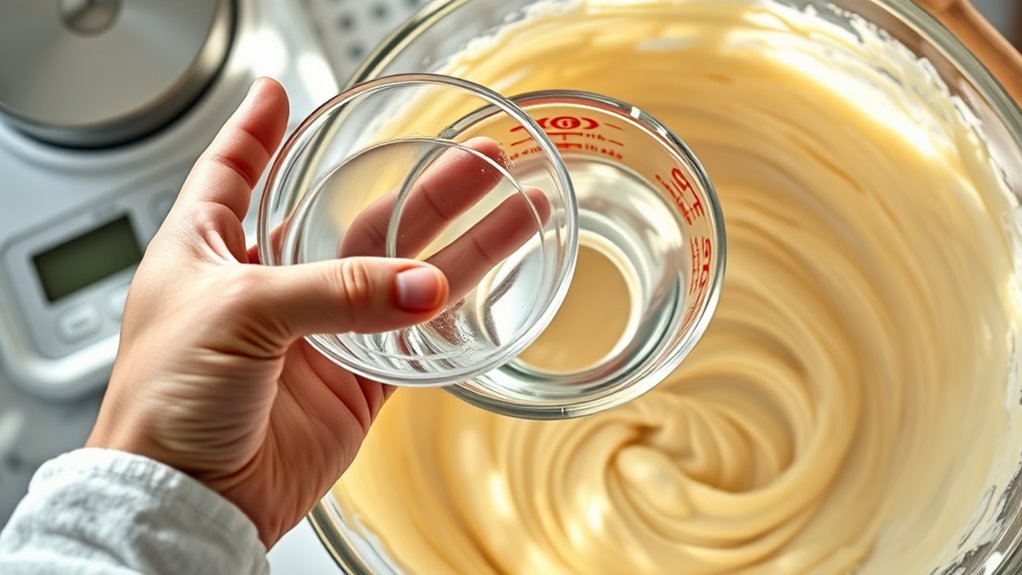
Adjusting water and butter levels can often resolve common batter issues. When your batter is too heavy on butter, it can affect flavor pairing and presentation aesthetics, making your baked goods dense or greasy. To troubleshoot:
- Reduce butter slightly to improve texture without sacrificing flavor.
- Increase water or liquid to balance richness and create a smoother batter.
- Check ingredient temperatures—cold butter can hinder proper mixing, while warm water enhances hydration.
- Test small batches to find the perfect water-butter ratio, ensuring your batter looks inviting and tastes harmonious.
Frequently Asked Questions
Can Adding More Water Improve Batter Stability Without Altering Flavor?
Adding more water can definitely improve batter stability by enhancing dough elasticity and reducing batter spread. When you increase water, the batter becomes more cohesive, making it easier to handle and less likely to over-spread during baking. Importantly, this adjustment usually doesn’t alter the flavor, so you get better stability without sacrificing taste. Just make sure you add water gradually, monitoring the batter’s consistency to achieve ideal results.
How Does Humidity Affect Water Measurement Accuracy in Baking?
Think of baking like sailing through fog; humidity effects can cloud your water measurements. High humidity adds moisture to the air, causing water evaporation from your ingredients and making your measurements less accurate. Conversely, low humidity can lead to drier ingredients. You should adjust water content accordingly, as fluctuating humidity levels impact how much water your batter truly needs for perfect consistency. Staying aware helps you sail smoothly through baking.
Are There Substitutes for Water to Adjust Batter Moisture Levels?
You can use fruit juice or milk substitutes to adjust batter moisture levels instead of water. These options add flavor and moisture, helping you avoid a butter-heavy batter. For example, apple juice or almond milk work well, depending on your recipe. Just keep in mind that these substitutes may alter the taste and texture slightly, so adjust other ingredients accordingly to achieve the desired batter consistency.
What Impact Does Water Temperature Have on Batter Consistency?
Sure, because everyone loves a science experiment in the kitchen, right? Temperature effects on batter viscosity are real; cold water thickens your mix, making it stiff and harder to work with, while hot water loosens it up, risking a runny mess. You can’t ignore this delicate balance—hotter water decreases viscosity, giving you a more fluid batter, and colder water increases it, creating a thicker consistency. Adjust accordingly for perfect results.
How Can I Modify Water Content for Gluten-Free or Alternative Flours?
When working with gluten-free flour or alternative flours, you need to adjust the water ratio to achieve proper hydration. Since these flours often absorb more or less water than wheat flour, you should start with a lower water amount and gradually add more until your batter reaches the right consistency. Pay close attention to how your dough feels and make adjustments accordingly, ensuring ideal texture and structure.
Conclusion
By mastering the dance between water and butter, you’re like a skilled conductor guiding a symphony of ingredients. When you measure carefully and adjust with precision, your batter becomes a smooth, harmonious melody—not a heavy, off-key tune. Think of water as the breath that keeps everything lively, and butter as the rich melody. With these tools, you’ll craft batter that sings with perfect balance, turning your baking into an artful masterpiece.
